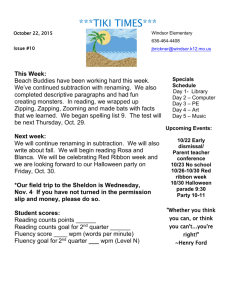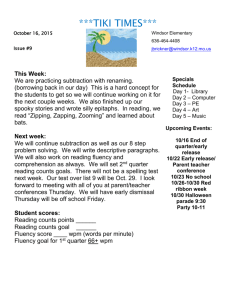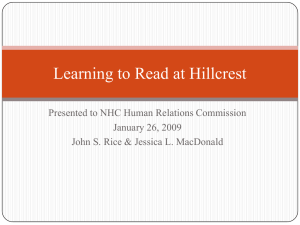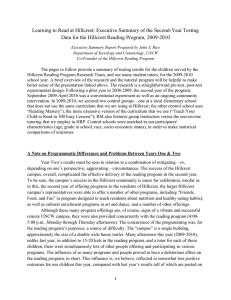Learning to Read at Hillcrest: Executive
advertisement
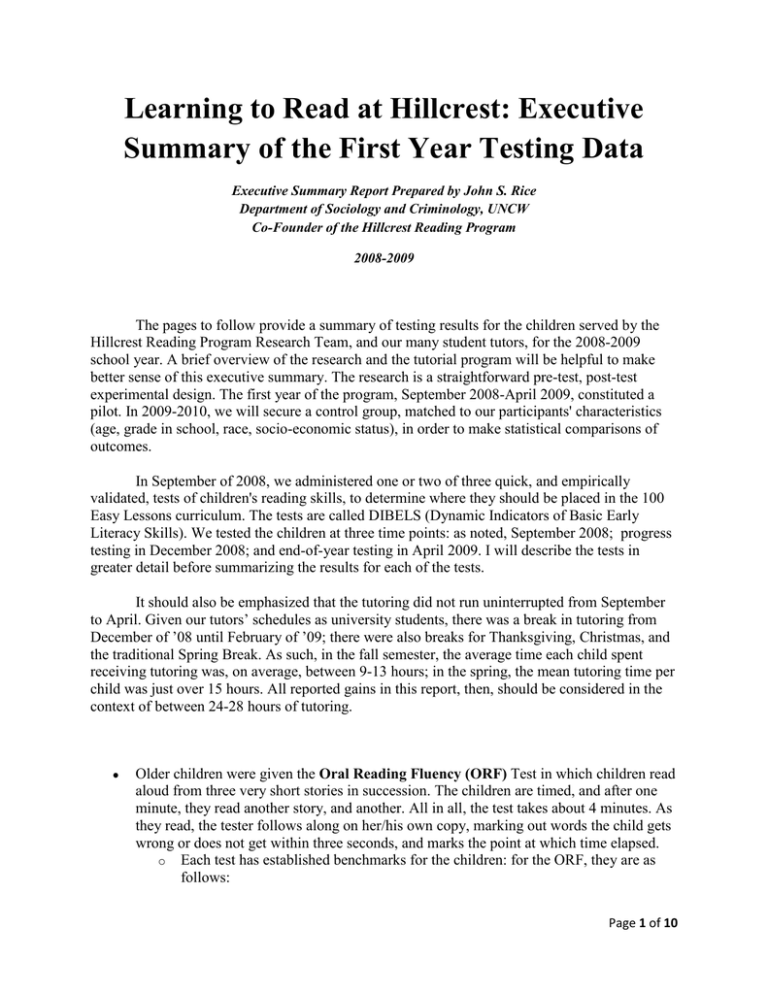
Learning to Read at Hillcrest: Executive Summary of the First Year Testing Data Executive Summary Report Prepared by John S. Rice Department of Sociology and Criminology, UNCW Co-Founder of the Hillcrest Reading Program 2008-2009 The pages to follow provide a summary of testing results for the children served by the Hillcrest Reading Program Research Team, and our many student tutors, for the 2008-2009 school year. A brief overview of the research and the tutorial program will be helpful to make better sense of this executive summary. The research is a straightforward pre-test, post-test experimental design. The first year of the program, September 2008-April 2009, constituted a pilot. In 2009-2010, we will secure a control group, matched to our participants' characteristics (age, grade in school, race, socio-economic status), in order to make statistical comparisons of outcomes. In September of 2008, we administered one or two of three quick, and empirically validated, tests of children's reading skills, to determine where they should be placed in the 100 Easy Lessons curriculum. The tests are called DIBELS (Dynamic Indicators of Basic Early Literacy Skills). We tested the children at three time points: as noted, September 2008; progress testing in December 2008; and end-of-year testing in April 2009. I will describe the tests in greater detail before summarizing the results for each of the tests. It should also be emphasized that the tutoring did not run uninterrupted from September to April. Given our tutors’ schedules as university students, there was a break in tutoring from December of ’08 until February of ’09; there were also breaks for Thanksgiving, Christmas, and the traditional Spring Break. As such, in the fall semester, the average time each child spent receiving tutoring was, on average, between 9-13 hours; in the spring, the mean tutoring time per child was just over 15 hours. All reported gains in this report, then, should be considered in the context of between 24-28 hours of tutoring. Older children were given the Oral Reading Fluency (ORF) Test in which children read aloud from three very short stories in succession. The children are timed, and after one minute, they read another story, and another. All in all, the test takes about 4 minutes. As they read, the tester follows along on her/his own copy, marking out words the child gets wrong or does not get within three seconds, and marks the point at which time elapsed. o Each test has established benchmarks for the children: for the ORF, they are as follows: Page 1 of 10 Benchmarks for Oral Reading Fluency Test Grade Level Spring of 1 Grade Spring of 2nd Grade Spring of 3rd Grade Fluency Rate (Words per Minute) 40 WPM 90 WPM 110 WPM st Chart 1: Oral Reading Fluency Rate, All Children T1: September 2008, pre-testing T2: December 2008, mid-year progress testing T3: April 2009, end of year testing Children’s Initials identified below each bar graph row 604 639 105 0 53 52 90 53 89 C.F. M.W. (3rd) (3rd) 71 12 101 19 40 0 32 73 57 159 52 14163 39 17 8 16 128 107 Correct – T1 T.P. (3rd) J.P. (2nd) Correct –T2 A.S. (2nd) 53 418 101 120 78 Z.W. (3rd) 392 T.W. (2nd) Correct -- T3 76 48 M.W. (2nd) Total Net Gain Page 2 of 10 This chart shows the progress of all of the older children (grades 2-3) that participated in the reading program throughout the year. Because some of the children graduated from 100 Easy Lessons in the fall 2008 semester, and others either stopped coming to the program, or joined us later in the year, for all of the tests there are no testing data for some of the participants at one or another of the testing periods. For example, C.F. and Z.W. (above) finished 100 Easy by December 2008. As such, I have included both rates for all of the participants as well as adjusted rates for each of the testing measures (see below). The adjusted rates are called for because the all-children rates, given the variations in participation, artificially reduce the groups’ rate of progress: Z.W. and C.F., for example, did not get zeros in T3; they simply were not tested. Given the established DIBELS benchmarks, M.W., the third-grader, went from being seriously at-risk, in September (19 WPM at T1), to being almost at grade level (90 WPM, the benchmark is 110 WPM by spring of third grade), by the time we tested in April. With the exception of J.P., the other three second-graders are no longer at risk, and are, indeed, well ahead of the second-grade benchmarks. A.S. leads the pack here, not surprisingly. She was well ahead of them when she started the program (107 WPM in September), and now reads 159 WPM, which is 49 WPM higher than she should be able to read in spring of her third-grade year. Much the same may be said of T.W., whose T3 fluency rate is now close to the spring of third-grade level. J.P. and M.W., at 73 and 101 WPM, respectively, also made substantial gains. M.W. has become a book-lover, and we are confident that he will be at grade level next year. J.P. is still 17 WPM behind the expected rate for second-graders, but he made impressive gains this year, as well. Page 3 of 10 Chart 2: Oral Reading Fluency Rate, Adjusted, Testing Times - T1-T3 604 328 433 90 71 32 53 19 73 40 17 8 39 16 159 57 52 141 63 128 120 107 78 M.W. (3rd)T.P. (3rd) J.P. (2nd) Correct – T1 A.S. (2nd) Correct –T2 T.W. (2nd) 53 101 276 76 48 M.W. (2nd) Correct -- T3 Total Net Gain Chart 2 summarizes the gain in oral reading fluency for the children that participated in the Reading Program for the entire first year of the program (the data are “adjusted” insofar as this chart includes only those children that were with us all year). As the chart shows, all of the children made substantial gains in the numbers of words they were able to read correctly in one minute: left to right, M.W. (3rd grade) had a net gain of 71 words per minute (she also went from being seriously at risk to almost catching up to grade level, by the end of the year, according to the DIBELS benchmarks; T.P. – who has been diagnosed with a learning disability – improved from her initial score of 8 words per minute (with 7 accompanying errors – see ORF Error chart, below) to 40 words per minute, for a net gain of 32 words per minute. Despite her substantial gains, T.P. is still at-risk. A.S., T.W., and M.W. (2nd grade), are all above the second-grade benchmarks. Chart 2 also underscores the importance of providing the adjusted rates. Although, as we saw in Chart 1, the eight children that participated for at least one semester had a net gain of 392 words per minute over the course of the program, their average gain was 44 WPM; the six Page 4 of 10 children that participated all year had a smaller net gain, overall – 328 WPM – but their average gain per child was just over 10 WPM more: just over 54 WPM. Chart 3: Oral Reading Fluency Error Rate, All Children, Testing TimesT1-T3 40 13 0 3 0 14 18 3 3 1 0 2 6 1 C.F. (3rd) M.W. (3rd) Z.W. (3rd) -1 7 51 4 3 3 2 1 2 0 0 1 0 3 0 3 0 20 2 1 9 15 T.P. (3rd) Errors – T1 J.P. (2nd) Errors – T2 A.S. (2nd) T.W. (2nd) Errors -- T3 M.W. (2nd) Total Net Gain This chart shows the children’s progress in their oral reading fluency error rate from September of 2008 through May of 2009; i.e., the number of errors the children made on the ORF tests. As a group, at T1 the children made a total of 51 errors; by T3, those had been cut to 9 errors. This comprises a net gain of 40 fewer errors; on average, 5 fewer errors apiece. Much more striking are the gains made by the two M.W.s, whose gains, combined, total 31 of the total 40-word net gain. Page 5 of 10 Chart 4: Oral Reading Fluency Error Rate, Adjusted, Testing Times-T1-T3 50 38 45 40 35 18 47 13 30 25 4 20 15 10 5 0 3 1 14 3 6 7 3 2 1 20 0 0 0 3 0 M.W. T.P. (3rd) J.P. (2nd) (3rd) Errors – T1 1 2 A.S. (2nd) Errors – T2 0 2 9 1 3 T.W. (2nd) 13 M.W. (2nd) Errors -- T3 Total Net Gain This chart shows the adjusted ORF error rate. Although this rate appears to show that this group made less net gain in the overall number of errors they committed in the one-minute DIBELS test, their rate is actually higher. Whereas all of the children, as we saw in Chart 3, had a collective average of 5 fewer errors, this group has just over 6 fewer errors. As noted above, the greatest gains were made by the M.W.s. The younger children were given either (in some cases, both) the Phoneme Segmentation Fluency (PSF) Test or the Nonsense Word Fluency (NWF) Test. Both are one-minute tests, and administration and scoring are the same as is used for ORF (above). o NWF is a check to see if children can sound out words they have never seen before (and likely will never see again); if they can they are developing the phonetic decoding skills necessary to becoming a good reader. The benchmark for this test is 50 Correct Letter Sounds by mid-1st grade. Page 6 of 10 Chart 5: Nonsense Word Fluency, All Children, Testing Times-T1-T3 250 226 200 202 150 52 100 50 52 0 29 62 30 35 23 0 54 53 28 0 F.S. (1st) I.M. (1st) A.P. (1st) 40 16 0 6 0 0 X.M. (K) S.C. (PT.W. (K) O.N. (K) K) Correct T1 Correct T2 52 Total Correct T3 Chart 5 summarizes the progress on the DIBELS Nonsense Word Fluency tests made by all children that participated in the program throughout the year. As with previous charts, it should be noted that these “all children” results must be understood in relation to the partial-year participation of three of the children: I.M. and O.N. stopped participating at the end of the fall semester; X.M. joined the program in February. We were disappointed that I.M. could not participate in the spring semester. She came a handful of times, but was not there enough to make tangible progress. As such, she was not tested in May. O.N. did not come at all in the spring. Our disappointment stems from the substantial progress I.M. had made in the fall, going from being unable to sound out any of the nonsense words in September to correctly identifying 53 by December, placing her ahead of the spring, 1st grade benchmark. Conversely, in O.N.’s case, the disappointment stemmed from our concern with his poor reading skills. He could’ve benefited from continued intervention. X.M. joined us in February after his mother learned about the program through community word-of-mouth. Given the rate of his progress in the spring, we are confident that he will exceed the 1st grade benchmark next year. Overall, as a group, the kids improved from 52 to 226 correct responses over the Page 7 of 10 course of the year: an average of just under 25 words per minute. Chart 6: Nonsense Word Fluency, Adjusted, T1-T3 77 80 70 60 30 39 30 50 40 16 22 30 20 10 0 0 S.C. (P-K) 0 1 T.W. (K) O.N. (K) T1 T2 1 Total T3 Chart 6 presents the adjusted rate of Nonsense Word Fluency: that is, again, the rate only for the children that participated regularly in the program for the full year. Of the children in kindergarten and first grade we served in the program, four fit that description. Whereas, as we saw in Chart 5, the rate for all children was just under 25 words per minute, the rate for these children revealed an average gain from 13 words per minute at T1 (52 WPM, divided among 4 children) to 43.5 WPM at T3 (203 WPM, divided by 4). Except for S.C.’s score of 28, all of the children met or exceeded the 1st grade benchmark; given that S.C. will start kindergarten next school year, we are confident that he will surpass that benchmark in his kindergarten year. F.S.’s lack of gain warrants further explanation. The research team discussed and has proposed a couple of explanations for the lack of progress from T2-T3. Both explanations center on his having “maxed-out.” First of all, his score of 52 exceeds the benchmark for his grade and Page 8 of 10 age level; as such, we are convinced that he’d rather have moved on to regular reading, rather than continued tutoring in phonemic awareness and the alphabetic principle, etc. (We perhaps should have tested him for Oral Reading Fluency, but that introduced problems of incommensurability. His baseline and progress tests were measured using the NWF tests.) The other sense in which he was maxed out was that by the end of the year, he was often cranky and tired, and did not want to participate in tutoring. This, of course, overlaps with the first problem: he was, in short, bored. Chart 7: Phoneme Segmentation Fluency Rate, All Children, T1-T3 77 80 70 60 30 39 30 50 40 16 22 30 20 10 0 0 S.C. (P-K) 0 1 T.W. (K) O.N. (K) T1 T2 1 Total T3 The PSF test determines whether, and how well, children recognize that words are made up of discrete sounds. The benchmark for this test is 35-45 Correct Letter Sounds (CLS) by spring of kindergarten or fall of 1st grade. As Chart 7 shows, S.C.’s progress all but certainly guarantees that he will be well ahead of grade-level skills by the time he reaches spring of his kindergarten year. So too, T.W. exceeded the DIBELS benchmark for CLS on this measure. O.N., as noted above, did not come in the spring and was not tested at T-3. Page 9 of 10 In sum, it was a very successful year in the Hillcrest Reading Program. Other than the exceptions noted in the above narrative, all of the children made substantial gains in the fundamental skills that predict whether children will go on to become successful readers. Two or three of the children are still not where they need to be, but the progress they made this gives them a solid foundation upon which to build further reading skills and to eventually catch up to where they should be. As we saw, several of the children are now as much as a year ahead of grade-level expected readings skills. Page 10 of 10

